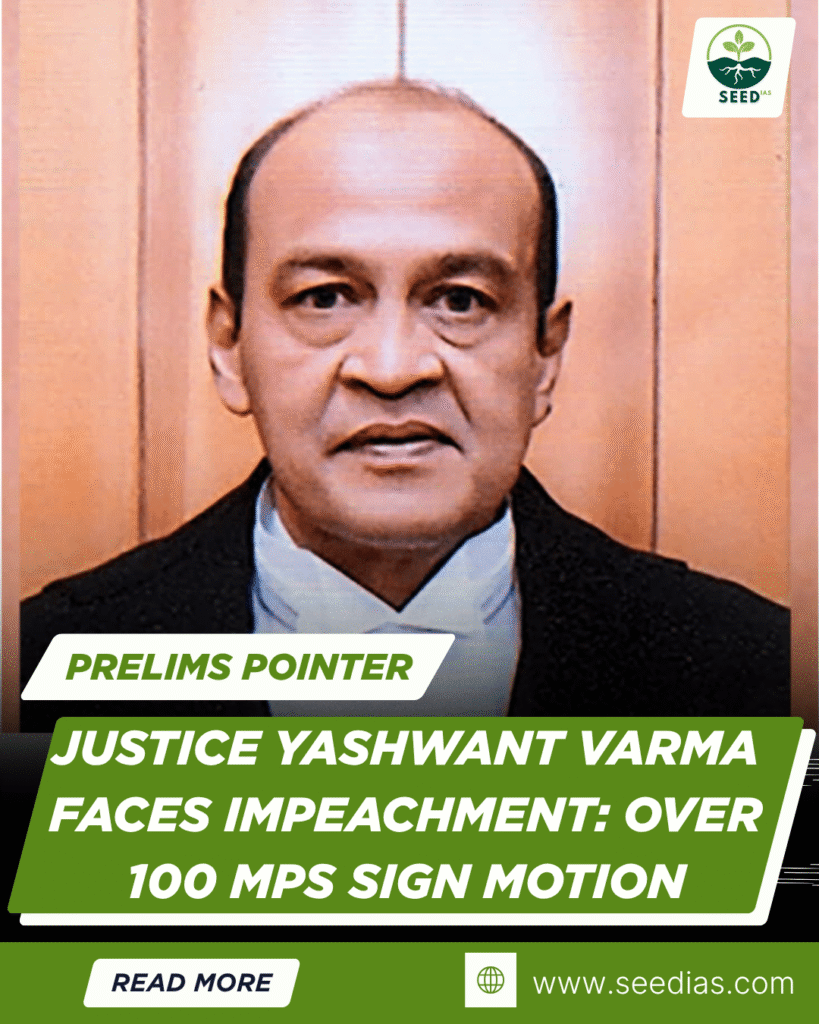Why in NEWS
Over 100 Members of Parliament (MPs) have signed a notice seeking the impeachment of Justice Yashwant Varma after a judicial panel found him guilty over sacks of burnt currency discovered at his residence during a fire in March 2025. Justice Varma has refused to resign and challenged the findings in the Supreme Court.
Key Concepts and Definitions
| Term | Explanation |
|---|---|
| Judicial Impeachment | Formal process to remove a judge of the Supreme Court or High Court for proved misbehaviour or incapacity. Though the term “impeachment” is not used in the Constitution, it’s the accepted term. |
| Article 124(4) | Provides for the removal of Supreme Court judges by a special majority in both Houses of Parliament. |
| Article 218 | Extends the same removal provisions to High Court judges. |
| Judges (Inquiry) Act, 1968 | Legal framework to regulate the inquiry into allegations against judges. |
News Details (Simple Summary)
- The motion was signed by over 100 MPs and submitted to the Speaker.
- It follows a judicial inquiry committee report that found Justice Varma guilty of serious misconduct.
- Despite a recommendation for resignation by Chief Justice Sanjeev Khanna, Justice Varma refused to step down.
- He has approached the Supreme Court challenging the inquiry findings.
Judicial Impeachment Process in India
| Stage | Details |
|---|---|
| Initiation | Motion introduced in either House with support of at least 100 Lok Sabha or 50 Rajya Sabha MPs. |
| Speaker/Chairman Decision | Motion accepted or rejected by Speaker (Lok Sabha) or Chairman (Rajya Sabha). |
| Inquiry Committee | A 3-member panel formed under Judges (Inquiry) Act includes: a Supreme Court judge (or CJI), Chief Justice of a High Court, and an eminent jurist. |
| Report Submission | If the judge is found guilty, report is submitted to the initiating House. |
| Parliamentary Debate & Vote | Both Houses must pass the motion in the same session with special majority: absolute majority of total membership and 2/3rd of members present and voting. |
| Presidential Order | If passed in both Houses, the President signs the removal order. |
Challenges in Judicial Impeachment
| Issue | Impact |
|---|---|
| Judge can resign mid-process | Leads to abrupt end of proceedings, denying closure and accountability. |
| High voting threshold | Makes impeachment politically difficult to complete. |
| No successful impeachment | Till date, no judge has been removed through this process in independent India. |
Notable Impeachment Attempts in India
| Judge | Outcome |
|---|---|
| Justice V. Ramaswami (1993) | Found guilty by inquiry committee; motion failed in Lok Sabha due to Congress abstention. |
| Justice Soumitra Sen (2011) | Rajya Sabha passed impeachment; he resigned before Lok Sabha could act. |
In a Nutshell (Memory Code)
“100 MPs, 0 Removals”
(Despite many motions, India has never successfully impeached a judge.)
Prelims Questions
- Which Article of the Indian Constitution provides for the removal of Supreme Court judges?
A) Article 122
B) Article 124(4)
C) Article 226
D) Article 312 - Under which law is the inquiry committee for judge removal constituted?
A) Contempt of Courts Act, 1971
B) Judges (Inquiry) Act, 1968
C) Judicial Standards and Accountability Act, 2010
D) Prevention of Corruption Act, 1988 - What is required for a judge’s removal motion to pass in Parliament?
A) Simple majority in either House
B) 2/3rd of members of both Houses present
C) Absolute majority and 2/3rd of members present and voting in both Houses
D) President’s approval alone
Prelims Answers and Explanations
| Q No. | Answer | Explanation |
|---|---|---|
| 1 | B | Article 124(4) deals with the procedure for removing SC judges. |
| 2 | B | The Judges (Inquiry) Act, 1968 provides the inquiry process for judicial removal. |
| 3 | C | The process requires both absolute majority and two-thirds majority of those present and voting. |
















